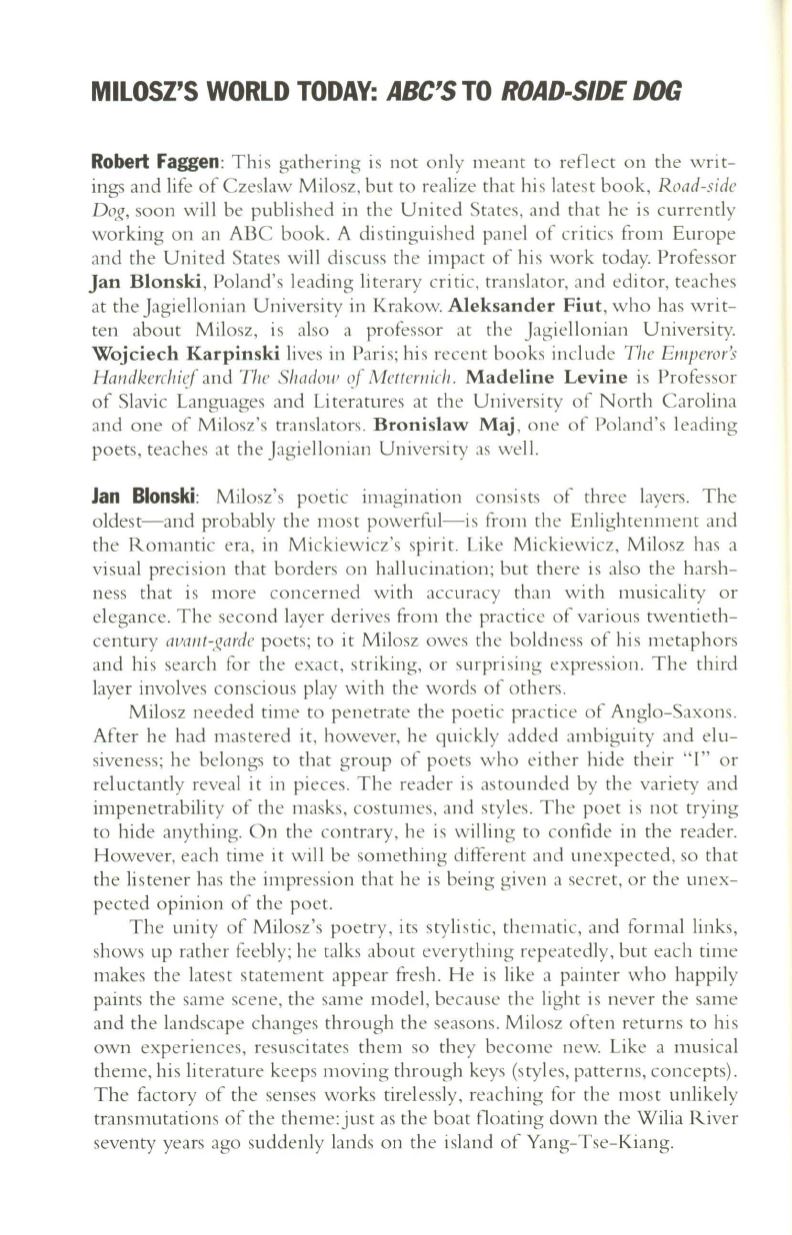
MILOSZ'S WORLD TODAY: ABC'STO ROAD-SIDE DOG
Robert Faggen:
Thi s ga thering is not only mea nt to refl ec t o n the writ–
ings and life of Czeslaw Mil osz, but to reali ze that hi s lates t book,
R oad-side
Dog,
soon will be publi shed in the United States, and that he is currently
working on an ABC book. A di stingui shed panel o f cri ti cs from Europe
and the United States will di scuss th e impact o f hi s work today. Professor
Jan Blonski,
Poland 's leading literary criti c, translator, and editor, teaches
at the Jagiell oni an University in Krakow.
Aleksander Fiut,
who has writ–
ten about Mil osz, is also a professo r at the Jagiell oni an University.
Woj ciech Karpinski
lives in Pari s; hi s recent books include
The Emperor's
Handkerchiif
and
The Shadolll of Metfemirll.
Madeline Levine
is Professor
of Slavic Languages and Literatures at the University o f N orth C arolina
and one of Mil osz's translators.
Bronislaw Maj ,
one o f Poland' s leading
poets, teaches at th e Jagielloni an University as we ll.
Jan Blonski:
Milosz's poetic imaginati on consists of three layers. The
oldest-and probably th e most powerful- is from th e Enli ghtenment and
the R omanti c era, in Mi cki ewi cz's spirit. Like Mi cki ewi cz, Milosz has a
visual precision that borders o n hallucination; but there is also the harsh–
ness that is more concerned wi th accuracy than wi th musicali ty or
el egance. The second layer derives from th e practi ce o f various twenti eth–
century
alJallf-izarde
poets; to it Mil osz owes th e bo ldness of his metaphors
and hi s search for th e exact, striking, or surpri sing expressio n. The third
layer involves conscio us play with th e words o f o th ers.
Mil osz needed time to penetrate th e poe ti c practi ce o f Anglo-Saxons.
After he had mas tered it, however, he qui ckly added ambi guity and elu–
siveness; he belongs to that group of poets who either hide their " }" or
reluctantly reveal it in pi eces. The reader is as to unded by th e vari ety and
impenetrability o f the masks, costumes, and styles. Th e poet is not trying
to hide anything. On the contrary, he is willing to confide in the reader.
However, each time it will be something different and un expected , so that
the listener has the impression that he is bein g given a sec ret, or the unex–
pected opinion of the poet.
Th e unity of Milosz's poetry , its styli sti c, themati c, and formal links,
shows up rather feebly; he talks about everything repea tedl y, but each time
makes the lates t statement appear fresh. He is like a painter who happily
paints the same scene, the same model , beca use the li ght is never the same
and the landscape changes through the seasons. Mil osz often returns to hi s
own experi ences, resuscitates th em so th ey become new. Like a musical
theme, hi s literature keeps moving throu gh keys (styles, patterns, concepts) .
The fa ctory of the senses works tirel essly, reaching for the most unlikely
transmutations of th e theme:just as the boat fl oa tin g down the Wili a River
seventy years ago suddenly lands on th e island of Yang-T se-Kiang.


